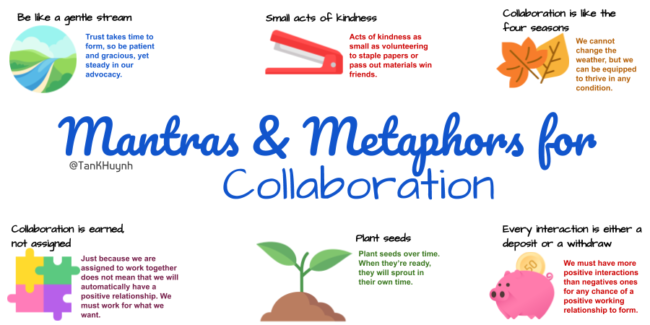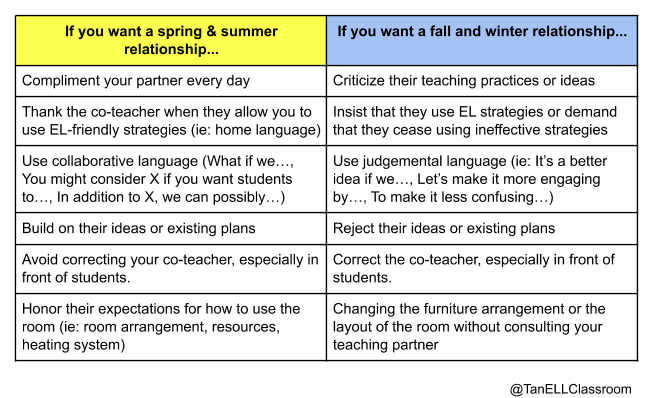I often hear EL teachers painfully retell their experiences with co-teachers using phrases like these:
- “My teacher doesn’t want to collaborate!”
- “They don’t give me time to teach the class.”
- “My teaching partner says there’s no time to plan.”
When I hear complaints like these, I gently and subtly reframe the discussion by suggesting, “When teachers are not yet comfortable with collaboration, you can…” and then continue the conversation. Working with teachers can sometimes be sensitive and require advanced emotional intelligence, so I would like to offer a few metaphors and mantras for effective collaborative relationship building.
Collaboration is earned, not assigned
We have to remember that we must first earn the trust of our assigned teaching partner if we want the relationship to be fruitful. Simply being assigned to a teacher does not mean that they are willing or ready to collaborate with you. It might be the first time that they are asked to teach collaboratively, or they might feel like they’re being evaluated by having another adult present. Most teachers are used to working alone with their students, as this is the traditional model. These teachers might require a significant amount of time to become comfortable with collaboration, and so most of our initial work needs to be poured into establishing a foundation of trust.
The Gentle Stream
Another metaphor I offer is that of a stone in a river. Imagine a rock with many sharp edges. When we place it in a stream, the edges wear away over time as the stream gently and consistently flows over the rock. I encourage you to take this long-term approach to collaboration. When we can be consistently positive, we create the culture that is conducive and inviting for our co-teacher to reach out and seek chances to collaborate. If we fail to produce this culture because we adults cannot “play nicely,” our students ultimately pay the highest price.
Every interaction is either a deposit or a withdraw
Because our first priority is to establish trust, we have to remember that our actions in a relationship are like banking transactions, with each interaction serving as either a deposit or a withdrawal. The Gottman Institute coined a theory called “The Magic Relationship Ratio.” They suggest that for a positive relationship to be formed and remain sustainable, we need to have five positive interactions for every one negative one. Applying this to teacher collaboration, we need to make sure that we have more positive interactions than negative when interacting with our co-teachers.
Collaboration is like the four seasons
For each collaborative relationship I enter into, I gauge the teacher’s readiness and willingness to work together. I compare his or her readiness and willingness levels to different seasons.
- Spring: moving in a positive direction
- Summer: excited to work together
- Fall: hesitant but not resistant, cool but not cold
- Winter: resistant, relationship at its coldest
With this framework, I know how I should interact with my co-teacher. Just like we have ways to keep cool in the warmer seasons and ways to bundle up to stay warm in the colder ones, we can thrive in any co-teaching relationship we find ourselves in.
Plant seeds
After I share this Seasons framework, EL teachers often tell me, “I have a winter teacher.” I always have them reframe it by having them say, “Because our relationship is currently in a winter phase…” This reframing reminds teachers that they make-up 50 percent of their co-teaching relationship. Combining the Magic Relationship Ratio and the seasons framework, we can affect how cold or warm our relationship becomes. Every interaction either causes a thawing of a chilly relationship or cools a warm one.
Here are practices that help nurture positive, trusting relationships, as well as practices that should be avoided.
I offer this quote by George Santayana to support your work in creating a positive relationship with your co-teacher:
To be interested in the changing seasons is a happier state of mind than to be hopelessly in love with spring.
Smalls act of kindness
I am not above any task, and no task that my co-teacher does is below me. Therefore, when my co-teacher is passing out papers, I rush to help pass out some. When they are stapling stacks of papers, I find a stapler and join them. When they’re at the board and erasing the left side, I’m there erasing the right side. If we’re working over lunch, I offer to take their plates to the cafeteria. Small acts of kindness go a long way in developing a relationship based on respect and trust. Sir Ken Robinson said that, “You cannot make a plant grow. You can provide the conditions for growth.”
Of all the resources on collaboration, I highly recommend Collaborating for English Learners: A Foundational Guide to Integrated Practices by Dr. Andrea Hongisfeld and Dr. Maria Dove, who are the gurus of collaboration for teachers of ELs.
Benson, Kyle. “The Magic Relationship Ratio, According to Science.” The Gottman Institute, Https://Www.gottman.com 5 Min Read 124,265 That “Magic Ratio” Is 5 to 1. This Means That for Every Negative Interaction during Conflict, a Stable and Happy Marriage Has Five (or More) Positive Interactions. 30 Oct. 2018, www.gottman.com/blog/the-magic-relationship-ratio-according-science/.



